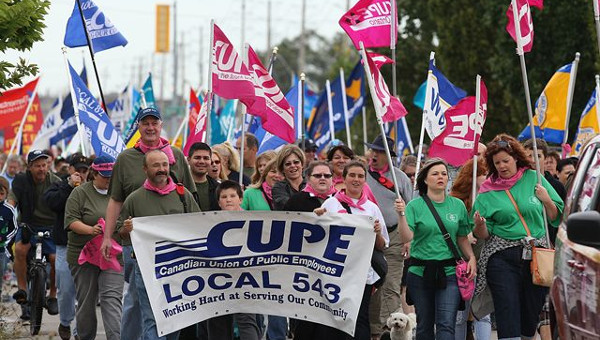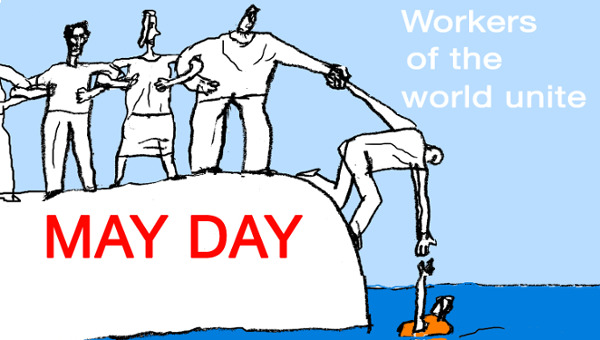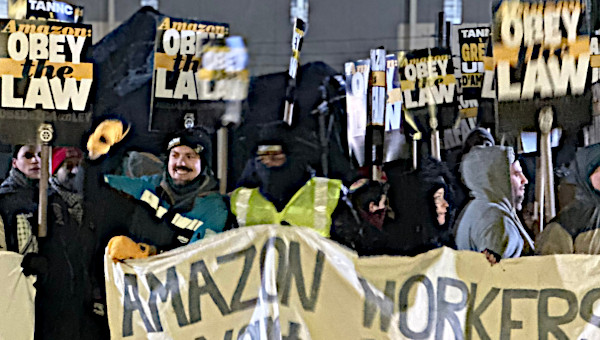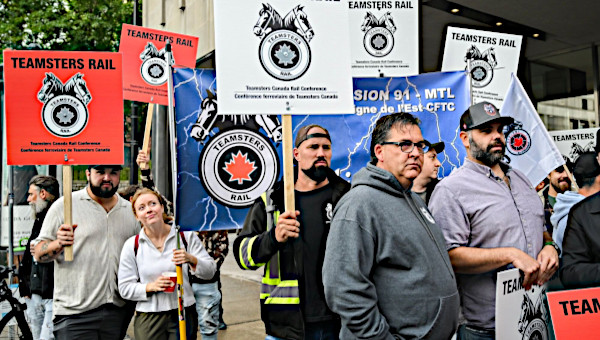The Windsor CUPE Strike: Implications for the Labour Movement and the Left
Negotiations are scheduled to resume on Thursday, July 9th, between Canadian Union of Public Employees (CUPE) Local 82 (outside workers) and Local 543 (inside workers) and the City of Windsor. Local 82 has been on strike since April 15th. Local 543 joined the picket lines a few days later. The strike continued much longer than anyone on either side anticipated and has been exacerbated by charges filed by CUPE with the Ontario Labour Relations Board alleging bad faith bargaining on the part of the City in relation to a media-leak that occurred in mid-June. The strike is an instance (rare in the current climate) of workers’ struggling for a political principle rather than immediate wage demands. As such, it has much to teach but also reveals complex challenges that both the labour movement and the Canadian Left will have to meet in the near future.
The Issues

The main issue at stake for both locals is the City’s demand that post-retirement medical benefits be eliminated for all future hires. The City’s position is that post-retirement benefits are an anachronistic quirk of a by-law passed in the 1950s which Windsor can no longer afford. The union has responded that depriving new hires of these benefits will not save the city any money for at least thirty years (existing workers’ benefits would be protected) and is in reality an unjust attempt to create two-tiers of employees. The general significance of this issue has two-dimensions. The first concerns the ability of CUPE to sustain the strike over three months when, aside from a demand for a modest wage increase, existing workers do not stand to materially benefit from it. The second dimension concerns an emerging pattern of attacks on benefits and threats to pensions. This pattern has become noticeable in the re-opening of auto worker contracts, the recent negotiations at Air Canada and again in the Toronto CUPE strike. I will discuss each of these dimensions in turn.
The fortitude the striking workers have demonstrated has deprived right-wing critics of the strike of the ammunition they employed to attack Canadian Auto Workers (CAW) members in their recent forced “negotiations” with Chrysler and General Motors (GM). Auto workers were castigated as short-sighted money-grubbers interested only in their own bottom line and oblivious to the new “economic realities.” The CUPE strike is a battle over the principle of intergenerational equality between workers. That these 1800 men and women have been able to hold out over three months at great personal cost, both in terms of lost wages and the opprobrium to which they have been subjected by many of their fellow citizens whose garbage they haul and whose complaints they deal with shows that the spirit of solidarity and commitment to general principles of justice has not been completely lost in the labour movement. This can only be seen as a positive development and must become more widely known and emulated.
Much more worrisome is the emerging negotiating strategy of trying to set different generations of workers at odds over differential pay scales and benefit packages. This strategy is best understood as a mutation of an older strategy, pioneered in the U.S. auto industry but now becoming legion, of protecting the hourly wage benefits of long-serving workers at the cost of fewer full-time positions, lower pay for new full-time hires, more contracting out to non-union shops, and reduced pension and other retirement benefits across the board. This strategy sets an ever-smaller core of middle-age long serving workers against the much more vulnerable young, entry level workers and older, retired workers who no longer enjoy the full bargaining power they had when working members of the union. Underlying this strategy is the belief that the small cohort of full-wage, full-benefit unionized workers will not compromise their own positions and wages for the sake of younger and older workers. The results in the auto industry confirm the success of this strategy; the results thus far in the Windsor strike prove that, at the very least, some workers are willing to strike on principle. The future of the union movement as the first line of working class defence against ruling class attempts to make working people pay for the recurrent crises of capitalism depends upon its discovering new ways to mobilize its membership against this new mutation of an old divide and conquer strategy. It also depends on building solidarity, the next critical issue of general significance raised by the strike.
Solidarity and Community Mobilization
The ability of CUPE to mobilize solidarity and community support has been uneven at best. Thus far there have been two major solidarity rallies, both organized by CUPE Ontario. The first was held on May Day, which brought a few hundred CUPE members to Windsor for a rally. CUPE members from 25 locals around the province were joined by a much smaller cohort of local labour leaders and community activists from groups such as the Windsor Worker’s Action Centre. Very few rank and file workers from other unions were present. A much larger rally of well over one thousand CUPE members from across Ontario was organized on Friday June 12th. This rally, which coincided with an international air racing festival being held in Windsor that weekend, was intended to increase the political pressure on the City at a time when it was in the international spotlight. Though large, the group was well-behaved and failed to
exert much leverage.
There have also been smaller mobilisations. The Windsor University Faculty Association (WUFA) organized a solidarity picket in late June, largely in repayment of a debt incurred to the campus CUPE local whose members honoured our picket lines for a day during the faculty strike in September. There was a disappointing turnout of about a dozen WUFA members. On June 29th there was a larger solidarity picket called by the Windsor District Labour Council. This rally did attract one hundred or so rank and file workers, mostly from the CAW, was spirited and managed to convince three local councillors, including Ken Lewenza Jr., son of CAW head Ken Lewenza, to respect the picket lines and not attend that night’s council meeting. Unfortunately, a deal was later brokered that allowed the three to cross. At that council meeting it was revealed that the City had begun to employ scabs to handle some of the City’s welfare case load. I will return to this issue below.
Before discussing the scabbing some general reflections about the lack of robust solidarity are in order. While the labour movement in Windsor can be justly proud of its history of militancy, its base in the auto industry has been savaged for the past five years. The crisis in the auto industry did not suddenly erupt with the fiscal crisis of September 2008. Windsor (population 220,000) has lost more than 15,000 manufacturing jobs over the past decade primarily as a result of the shift of manufacturing, especially in autos, to lower costs regions and countries. In 1998 there were at least nine auto industry factories employing more than 1000 workers in Windsor, today, there are two and one, the GM Transmission plant, will close in 2010. All of these closed or were scheduled to close prior to the onset of global economic crisis in 2008. In other words, the major industry of the community and the heart of its union militancy has been nearly completely destroyed. Coupled with the fact that the CAW was subjected to literal extortion at the bargaining table prior to the bankruptcy of Chrysler and GM, the reality is that the organized working class in Windsor is emotionally exhausted and defensive. In this context it has been difficult to mobilize large scale solidarity events, and when these have been mobilized they are largely symbolic rather than extensions of the immediate struggle into the community at large. This has enabled the City to prolong the strike by more or less refusing to seriously bargain. The strike has been further prolonged by two somewhat novel problems which I will discuss by way of conclusion.
Cyber-Scabbing and the Underground Economy
At the City Council meeting of June 29th it was revealed that the city had begun using welfare case workers in adjoining counties to perform work normally done by Windsor CUPE members. Cyber-scabbing represents a novel and potentially serious threat to public sector unions. As a great deal of public sector union work is not site-specific cyber-scabbing cannot be combated in the usual manner, i.e., through mass pickets that physically prevent the scabs from accessing the shop floor. Computer mediated work can be done anywhere, a well-known fact that has received a great deal of attention in relation to the general problems it poses for working class organization. What has not received as much attention is the use of cyber-scabs as a more clandestine tactic to prolong strikes to the point at which the cohesiveness of the union breaks down. The use of cyber-scabs in Windsor was never announced and the union found out about it only because it was raised by one of the councillors at the meeting on the 29th. Whereas traditional scabs increase militancy in the short term, cyber-scabs are not in principle detectable by the union leadership. This fact raises serious issues that will require creative political and tactical thinking in the future.
Perhaps an even more novel problem that has arisen in the Windsor strike is the way in which workers in the underground economy have unwittingly contributed to a prolongation of the strike. The underground economy in Windsor is huge and growing, composed mostly of unemployed, highly skilled tradespeople from the auto industry who can and will do anything – fix your car, wire your house, install phone jacks, re-shingle your roof – for cash. One would think that after three months of a strike involving, among others, garbage collectors the city would be an unmanageable mess. Yet, by and large, it is not, because within weeks of the strike’s beginning dozens of private trash-haulers, many unemployed union members themselves, began hauling household garbage and recycling for cash. On the surface, this development can simply be dismissed as straightforward scabbing. At a deeper level however it expresses a key contradiction of organized labour as well as, perhaps in part, a new possibility for organizing and anti-capitalist mobilization.
Organized labour presupposes the commodification of labour-power and works within capitalist labour markets to represent the collective economic interests of the employed. While the unemployed formally remain union members, they have no bargaining power when there is no buyer for their labour-power. The underground cash economy is thus a form of waged work which is, nevertheless, partly outside of capitalist labour markets proper. The danger of this underground economy is being made clear in Windsor, in so far as it is in this case a form of money-value driven entrepreneurialism that has reduced the political and environmental pressure on the city to solve the strike. By keeping the city relatively clean underground trash services have made CUPE’s task at the bargaining table much more difficult.
The outcome of this important strike remains in doubt. Regardless of its eventual outcome, the ability of 1800 working people to hold out for three months is an important example of the re-emergence of principled politics in the union movement. Perhaps this principle will be given up this time, perhaps it will not. Not every struggle is successful in the short term. The CUPE Windsor strike proves that unions have not been reduced to wage cartels for a shrinking cohort of middle-aged workers. Nevertheless, it also reveals a new set of challenges that the union movement and the broader Canadian Left must analyse seriously for the sake of developing new tactics and strategies, new goals, and new thinking in the midst of a crisis presenting us with the best opportunity for socialist action in at least two decades. •





